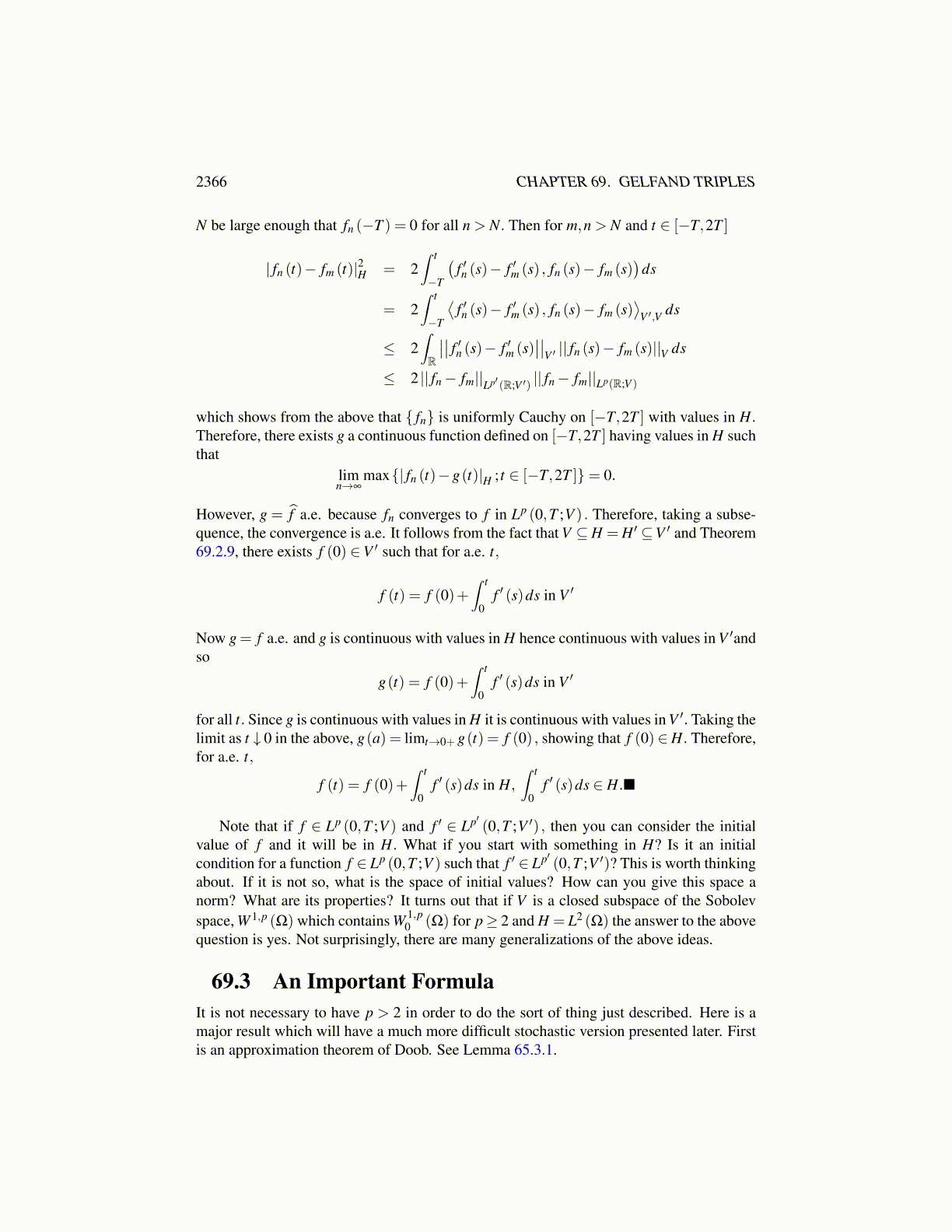
2366 CHAPTER 69. GELFAND TRIPLES
and for all t ∈ [0,T ] , ∫ t
0f ′ (s)ds ∈ H, (69.2.11)
and for a.e. t ∈ [0,T ] ,
f (t) = f (0)+∫ t
0f ′ (s)ds in H, (69.2.12)
Here f ′ is being taken in the sense of V ′ valued distributions and 1p +
1p′ = 1 and p≥ 2.
Proof: Let Ψ ∈C∞c (−T,2T ) satisfy Ψ(t) = 1 if t ∈ [−T/2,3T/2] and Ψ(t) ≥ 0. For
t ∈ R, define
f̂ (t)≡{
f (t)Ψ(t) if t ∈ [−T,2T ]0 if t /∈ [−T,2T ]
and
fn (t)≡∫ 1/n
−1/nf̂ (t− s)φ n (s)ds (69.2.13)
where φ n is a mollifier having support in (−1/n,1/n) . Then by Minkowski’s inequality∣∣∣∣∣∣ fn− f̂∣∣∣∣∣∣
Lp(R;V )=
(∫R
∣∣∣∣∣∣∣∣ f̂ (t)−∫ 1/n
−1/nf̂ (t− s)φ n (s)ds
∣∣∣∣∣∣∣∣pV
dt)1/p
=
(∫R
∣∣∣∣∣∣∣∣∫ 1/n
−1/n
(f̂ (t)− f̂ (t− s)
)φ n (s)ds
∣∣∣∣∣∣∣∣pV
dt)1/p
≤(∫
R
(∫ 1/n
−1/n
∣∣∣∣∣∣ f̂ (t)− f̂ (t− s)∣∣∣∣∣∣
Vφ n (s)ds
)p
dt)1/p
≤∫ 1/n
−1/nφ n (s)
(∫R
∣∣∣∣∣∣ f̂ (t)− f̂ (t− s)∣∣∣∣∣∣p
Vdt)1/p
ds
≤∫ 1/n
−1/nφ n (s)εds = ε
provided n is large enough. This follows from continuity of translation in Lp with Lebesguemeasure. Since ε > 0 is arbitrary, it follows fn → f̂ in Lp (R;V ) . Similarly, fn → f inL2 (R;H). This follows because p ≥ 2 and the norm in V and norm in H are related by|x|H ≤C ||x||V for some constant, C. Now
f̂ (t) =
Ψ(t) f (t) if t ∈ [0,T ] ,Ψ(t) f (2T − t) if t ∈ [T,2T ] ,Ψ(t) f (−t) if t ∈ [0,T ] ,0 if t /∈ [−T,2T ] .
An easy modification of the argument of Lemma 69.2.11 yields
f̂ ′ (t) =
Ψ′ (t) f (t)+Ψ(y) f ′ (t) if t ∈ [0,T ] ,Ψ′ (t) f (2T − t)−Ψ(t) f ′ (2T − t) if t ∈ [T,2T ] ,Ψ′ (t) f (−t)−Ψ(t) f ′ (−t) if t ∈ [−T,0] ,0 if t /∈ [−T,2T ] .
.